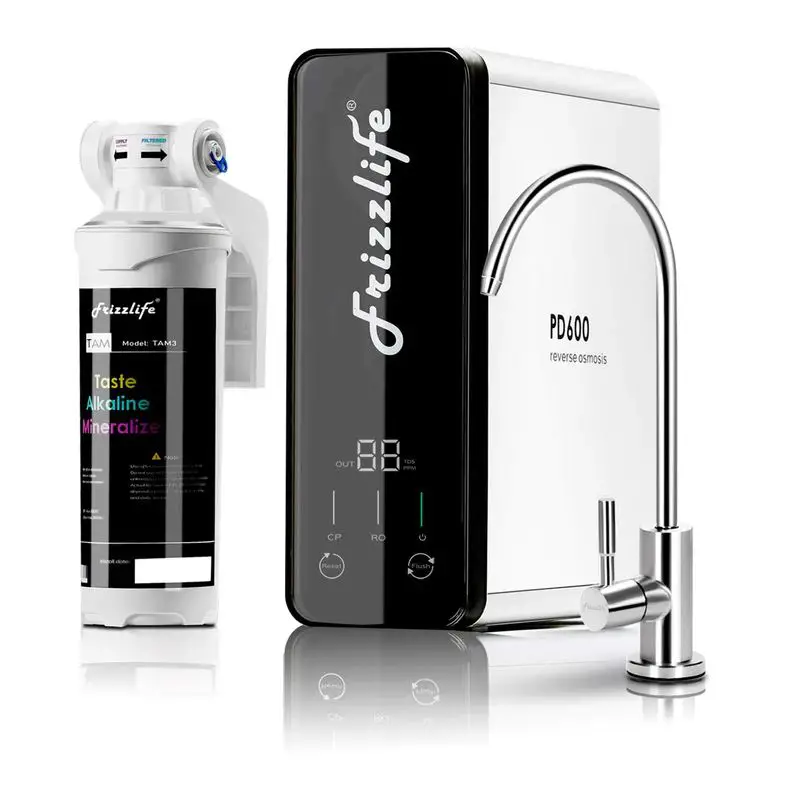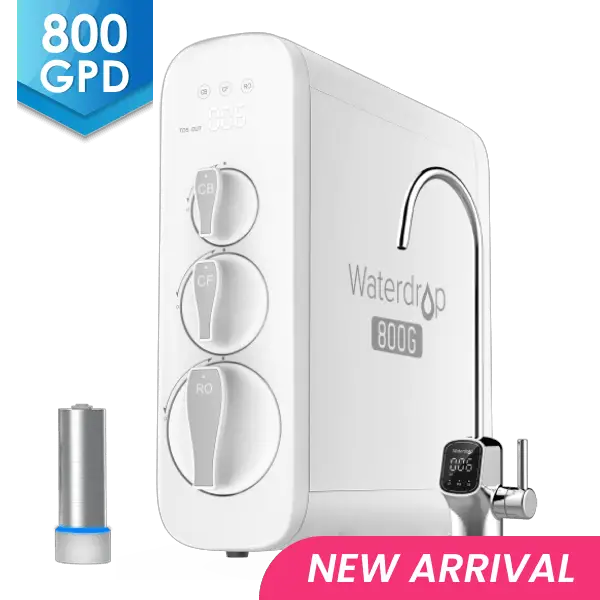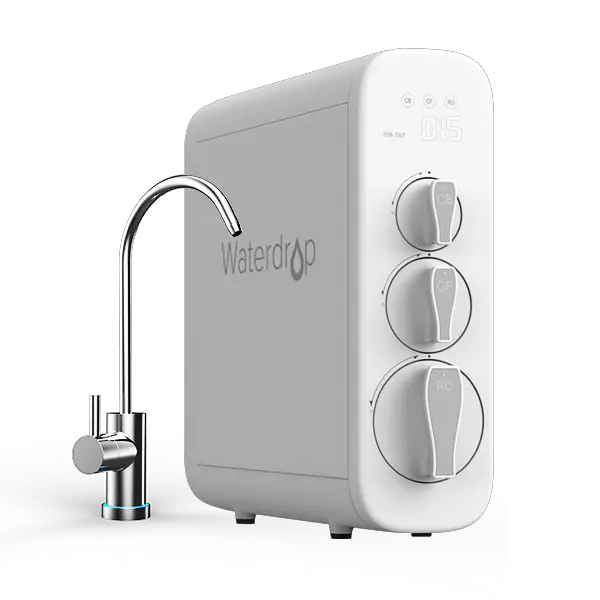Chlorine and chloramine are introduced to drinking water to remove disease causing microbes. However, these chemical compounds have a strong taste and bleach-like odor that is unpleasant to most people. Given that reverse osmosis is one of the most effective methods of water purification, many wonder if it can remove chlorine and chloramine and improve the taste of their water.
Reverse osmosis systems that utilize an activated carbon filter in conjunction with a semi-permeable membrane are able to effectively remove chlorine and chloramine from water.
In this article, we’ll explain what chlorine is and how it permeates your tap water. We’ll also discuss whether it’s necessary to remove it. We also discuss the best reverse osmosis systems to reduce or eliminate the chlorine from your drinking water.

What is chlorine and chloramine?
Over 90 percent of Americans get their tap water from public water systems, which are considered one of the safest in the world. The quality of the water is regulated by the U.S. Environmental Protection Agency (EPA), who monitors the levels of contaminants and establishes safety standards that water utilities must maintain.
The EPA approves the use of chlorine and chloramine as safe disinfectants to prevent the spread of waterborne diseases.
Chlorination and chloramination have been popular processes in municipal water treatments since the early 20th century. Some water providers do temporary switches between chlorine and chloramines at different times of the year to remove biofilm buildups in water pipes, fight different contaminants, or for other operational reasons.
Chlorine is a chemical element that constitutes just 0.017 percent of the Earth’s crust. At room temperature, it appears in the form of a greenish yellow gas known to be corrosive and toxic.
It is widely used in the manufacturing process of various products because it has effective bleaching and disinfecting properties. It plays a crucial role in the production of paper, textiles, pesticides, pharmaceuticals, rubber, PVC, solvents and more.
Only low concentrations of chlorine are used by water utilities, not enough to cause negative health effects on humans, but just the right amount to kill disease causing organisms like bacteria, cysts and viruses.
Although chlorine also has some disadvantages: it gives water a strong odor and taste that many people dislike (considered aesthetic effects), and it may react with other elements in water to form potentially harmful byproducts. These elements typically come from plant and animal waste that sometimes permeate drinking water supplies from nearby farms or urban runoff.
When the naturally occurring organic matter combines with chlorine, a chemical reaction causes the creation of water disinfection by-products such as trihalomethanes which are classified as possible human carcinogens.
On the other hand, chloramines are formed when ammonia is added to chlorine as part of the disinfection process. It’s also safe to drink and has some advantages over chlorine:
- It doesn’t break down as easily, so it lasts longer in the water pipes.
- It’s not as reactive, so it produces fewer byproducts.
- It doesn’t make water smell and taste like chlorine.
Many public water systems are slowly switching to chloramine disinfection to avoid the risks involved when using chlorine.
At the same time, reverse osmosis systems with activated carbon filters have the ability to capture and remove chlorine and trihalomethanes, common byproducts of chlorine disinfection likely to be carcinogenic after prolonged exposure.
How a reverse osmosis system works to remove chlorine and chloramine
The best methods known to reduce the concentration levels of chlorine and chloramine are activated carbon and ultraviolet radiation filters.
Within activated carbon filters, carbon blocks are generally more effective than granular activated carbon because they have more surface area, but they usually need to be replaced more often. The combination of activated carbon and UV radiation filters improves the dichlorination efficiency to up to 99%.
Reverse osmosis (RO) systems installed in residential properties use electrically driven feed pumps and osmotic pressure to reverse the flow of water and diffuse it through a semipermeable membrane. This ultimately means the system uses high pressure to force the water through a filter with very small holes (the membrane).
This membrane, with a pore size of approximately 0.0001 microns, allows water molecules to pass through into a storage tank, while blocking dissolved or suspended substances, including chlorine, volatile organic compounds and other contaminants, such as fluoride.
Water Purification Guide has detailed information on which reverse osmosis systems can remove fluoride available here.
The rejected (or waste) water is washed out through a secondary stream that’s drained away from the house.
These highly efficient systems often contain additional coagulants, sediment filters and activated carbon filters on either side of the membrane. Pretreatment filters are typically used to adjust chlorine concentration levels to prevent them from damaging the membrane surface.
Carbon blocks or granulated activated carbon filters capture and reduce the concentration of chlorine and chlorine byproducts.
Post-treatment filters such as ultraviolet sterilizers may be applied to reinforce the treated water’s purity. In some cases, certain filters are installed to remineralize the treated water with minerals such as potassium, calcium, magnesium and sodium to provide the necessary dietary intake that people are expected to get from their drinking water.
5 Reverse Osmosis systems that can remove chlorine
Reverse osmosis systems are among the most effective and energy efficient methods to filter drinking water. Combined with activated carbon and other filtration layers, they are extremely reliable not only in removing the unpleasant smell and odor of chlorine, but also in killing bacteria and removing potentially toxic chemicals.
It’s important to remember that these systems will not be able to remove chlorine (or other contaminants) if you don’t regularly replace the filters and sanitize the unit.
Here is a list of the 5 best reverse osmosis systems that remove chlorine and other contaminants from your tap water.
1. Waterdrop Reverse Osmosis System, G3P800
The Waterdrop G3P800 RO system is the upgraded version of the Waterdrop G3 unit mentioned later in the post. This improved model introduces a LED ultraviolet sterilizer stage and a scale inhibitor membrane to extend its lifespan.
Third party laboratory tests certify it has a 99.9% of reduction rate for chlorine, heavy metals and other contaminants making it the best RO at removing chlorine on our list!
A TDS monitor tracks the water quality, indicating when it’s time to replace the filters.
For a small unit, it produces a large amount of water (800 gallon per day) with an efficiency that translates to reduced waste (3:1 pure water to wastewater ratio) – which is excellent!
2. Frizzlife RO Reverse Osmosis Water Filtration System

This RO system by Frizzlife has three large filters and seven filtration layers, including an alkaline remineralization filter to restore minerals (calcium, potassium, magnesium and sodium) and produce weakly alkaline purified water. It has a carbon block that removes chlorine and a high daily throughput of 600 gallons per day.
Some smart features like a TDS meter allow for easy maintenance, and it has a good wastewater ratio of 1 gallon of wastewater for every 1.5 gallons of filtered water.
3. Waterdrop Reverse Osmosis System, WD-G3
This Waterdrop G3 RO system offers seven stages of filtration that combine different materials to remove more contaminants and expedite the filtering process.
The G3 has been built with advanced composite filter technology and a carbon block to remove contaminants such as chlorine and chloramine, as well as lead, arsenic (often combined with chlorine in the public water treatment), other heavy metals and potentially harmful organic contaminants.
A cross filtration method prevents the buildup of microbial biofilms, and a smart faucet indicates when the filter needs to be replaced. An automatic flushing system maintains the condition of the filters and extends their lifespan.
- Easy and simple to install
- Made from lead-free material
- Water flow is exceptional
- Boasts a wastewater to pure water ratio of 1:1
4. Express Water Ultraviolet Reverse Osmosis Water Filtration System
The Express Water RO system offers six filtration stages. By the time the water reaches the reverse osmosis membrane, it has already gone through a sediment filter and two activated carbon filters (a carbon block and a granular carbon filter).
The post treatment introduces an Ultraviolet filter to reduce disease-causing bacteria and cysts, effective enough to withstand the concentration levels found in well water. It has been independently tested by third party laboratories and is certified to remove chemical disinfectants (chlorine and chloramine) to up to 99.68%.
5. iSpring RCC7 Under Sink Reverse Osmosis Drinking Filtration System
This iSpring RO system offers five stages of filtration, including three pretreatment filters for sediments and chlorine, and a fine granular activated carbon final filter for extra purity. The membrane is rated for up to 75 gallons of water per day, which serves large families with plenty of drinking water clear of chlorine, lead, and other minerals.
This filtration system is built with simple but effective features, such as a reinforced transparent housing for the first stage filter, with long lifespans. There are no digital indicators for filter changes but it’s easy to inspect.
Does chlorine damage RO membranes?
Chlorine can damage reverse osmosis membranes. Most systems use an activated carbon pre-filter to remove chlorine prior to the water reaching the membrane. Many reverse osmosis membranes are sensitive to certain oxidizing agents such as chlorine. Some membrane materials, like ceramics, are more durable than others, like polymer membranes.
To prevent certain chemicals from corroding the semipermeable membrane, reverse osmosis systems often have a dechlorination filter that treats the water before its passage through the reverse osmosis process. This is typically an activated carbon filter.
A damaged membrane will reduce the pressure drop and decrease its efficacy at blocking unwanted contaminants.
How much chlorine is in RO water?
Studies show that activated carbon in reverse osmosis systems cannot completely remove chlorine but can reduce it to 50%. This is sufficient to improve the water’s taste and smell. RO systems with additional ozone or ultraviolet irradiation filters improve the efficiency of the dechlorination process to almost 99%.
Carbon block filters are generally more effective than granulated activated carbon filters. The amount of chlorine measured in post-treatment water varies depending on the levels present in the water before the filtration process.




